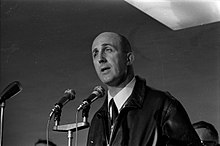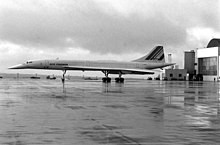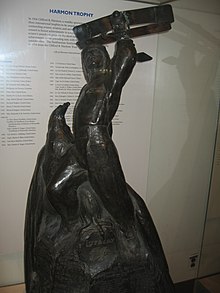André Turcat
André Edouard Marcel Turcat (born October 23, 1921 in Marseille ; † January 4, 2016 in Beaurecueil , Bouches-du-Rhône ) was a French test pilot , author , politician and art historian . He was significantly involved in the development of the Concorde and was its first pilot.
Life
Early years
André Turcat came from the family of the founders of the car manufacturer Turcat-Méry . He studied at the École polytechnique . Although he had never seen an airplane before, after graduating in 1942, he decided to pursue a career in the French Air Force . After beginning pilot training in Cognac in the Charente department , he was suspended along with other fellow aviators, including Jean Boulet , due to the provisions of the 1940 armistice with Germany . From 1943 to the liberation of France in 1944 he was a member of the organization Chantiers de la jeunesse française of the Vichy regime .
1947 to 1962: military pilot and record flights

He made his first flight in Châteauroux in the Indre department in a Morane-Saulnier MS.315 . In July 1947 he got his pilot's license. He took part in the Indochina War for three years and completed transport flights, mainly on Douglas C-47 aircraft .
In 1950 he came to the flight test center ( Center d'essais en vol , CEV) in Brétigny-sur-Orge and quickly rose to become the head of the school there for flight personnel on test and acceptance flights. In 1953 he became chief test pilot at the armaments company Société française d'étude et de construction de matériels aéronautiques spéciaux (SFECMAS) and then worked for its successor, Nord Aviation .
In the 1950s, Turcat set numerous flight records. In 1954 he was the first European pilot on the test aircraft Gerfaut I to break the sound barrier in a climb. In 1959 he set a new world speed record for 100 km sightseeing flights on a Griffon II with a top speed of Mach 2.19 with an average speed of 1,640 km / h, 460 km / h faster than the previous record.
1962 to 1976: Concorde
In 1962 he moved to Sud Aviation , where he became head of the testing department in 1964. In his tenure at Sud Aviation to Turcat began as a journalist and went in the press for the implementation of the criticized from many sides project for the supersonic airliner Concorde strong.
On March 2, 1969, Turcat was a pilot on the Concorde's maiden flight. He was also the commander of the flight on which the Concorde first reached supersonic speed on October 1 of the same year.
In 1973, at the Le Bourget air show , he narrowly escaped the crash of a plane from the Soviet rival model to the Concorde, the Tupolev Tu-144 , which killed everyone on board. Turcat had received an invitation to take part in the flight, but turned it down.
On March 31, 1976, just under four months after the Concorde was approved as a commercial aircraft, Turcat operated an aircraft of this type for the last time and then retired as a pilot.
Career after the end of the pilot's career

From 1971 to 1977 he was deputy mayor of Toulouse , where he was responsible for housing construction. After unsuccessful candidacy in the French parliamentary elections in 1978, he was a member of the European Parliament for the Gaullist RPR in 1980/1981 .
From 1983 he was the founding president of the French Aerospace Academy in Toulouse.
In the 1980s, Turcat began studying art history in Toulouse. In 1990 he received his doctorate there with a thesis on sacred art by the Renaissance sculptor Étienne Jamet , who worked in Spain . Turcat then taught in this field for ten years. In 2000 he began again to study, this time in Catholic theology in Strasbourg , which he graduated with a license .
After the crash of a Concorde on July 25, 2000 immediately after take-off from Paris-Charles-de-Gaulle Airport , Turcat once again supported the Concorde in the media and spoke out vehemently in favor of continuing its operations.
André Turcat died on January 4th, 2016 at the age of 94 in his retirement home near Aix-en-Provence . In his honor, several low and slow overflights of his grave with the prototype of the Airbus A350 were carried out on January 9, 2016 .
honors and awards
For his achievements as a record pilot on military jet aircraft, André Turcat received the American Harmon Trophy in 1959 , which was presented to him by then US Vice President Richard Nixon . He received this award again in 1970 for his flights with the Concorde.
He was Commander of the Legion of Honor , Grand Officer of the Ordre national du Mérite and Commander of the British Empire .
Works
- André Turcat: Concorde. Essais et batailles. Éditions Stock, 1977, ISBN 978-2-234-00541-9 .
- André Turcat: Concorde. Essais d'hier, batailles d'aujourd'hui . Nouvelle édition. Le Cherche Midi, 2000, ISBN 978-2-86274-820-7 .
- André Turcat: Pilote d'essais. Mémoires 1 . Le Cherche Midi, Paris 2005, ISBN 978-2-7491-0409-6 .
- André Turcat: Pilote d'essais. Mémoires 2 . Le Cherche Midi, Paris 2009, ISBN 978-2-7491-1374-6 .
- Guy Bedouelle, André Turcat: Les plus beaux textes de la Bible . Lethielleux, 2006, ISBN 978-2-283-61245-3 .
literature
- Pierre Sparaco: André Turcat: Biography . Editions Privat, 2015, ISBN 978-2-7089-9254-2 .
Web links
- Literature by André Turcat in the SUDOC catalog (Association of French University Libraries)
- Entry on André Turcat in the Members' database of the European Parliament
Individual evidence
- ↑ a b c d e f g h i j Dominique Buffier: Mort d'André Turcat, le pilote d'essai du Concorde. In: Le Monde . January 5, 2016, accessed January 5, 2016 (French).
- ↑ a b c d e Décès d'André Turcat, le premier pilote d'essai du Concorde. In: Les Échos . January 5, 2016, accessed January 6, 2016 (French).
- ^ A b André Turcat (1921-2016): First flight pilot of the Concorde died. In: Flight Revue . January 5, 2016, accessed January 6, 2016 .
- ↑ André TURCAT. European Parliament , accessed on 6 January 2016 .
- ↑ Sebastian Steinke: Airbus honors deceased Concorde test pilots. In: Flugrevue.de. Flug Revue , January 11, 2016, accessed January 11, 2016 .
- ^ New York Times, December 12, 1959
| personal data | |
|---|---|
| SURNAME | Turcat, André |
| ALTERNATIVE NAMES | Turcat, André Edouard Marcel (full name) |
| BRIEF DESCRIPTION | French test pilot, author, politician and art historian |
| DATE OF BIRTH | October 23, 1921 |
| PLACE OF BIRTH | Marseille |
| DATE OF DEATH | 4th January 2016 |
| Place of death | Beaurecueil , Bouches-du-Rhône department |


